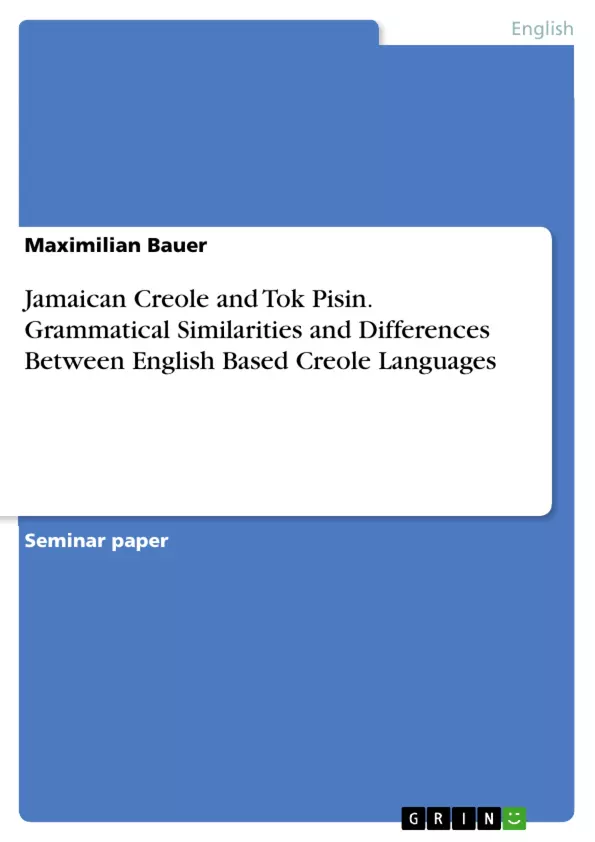As Colonization in Europe emerged more and more countries all over the world were seized by Spanish, German, Dutch, Danish and English troops. As there was a problem of communication a new language between the English troops and settlers and the native people came up that is nowadays called a Pidgin language. It was a mixture of the indigenous language and the language of the invaders from Europe. When later the British brought the first slaves from other colonies mostly in Africa they also had a huge impact on this Pidgin language.
As the time went by more and more of these colonies declared their independence but most of the influences to the life and the country in the colonies seemed irreversible. A very important impact was the one on the language of the former natives by African slaves and European settlers that inhabited the colonies for a long time. These influences can still be seen in modern times in education, lifestyle and of course the language. The Pidgin languages all over the world – today most of them developed to creoles – are still spoken. They have some distinct features in common but they also show differences concerning grammatical or syntactical features even if the spelling seems to be nearly the same.
Therefore in my opinion it is worthwhile taking a closer look to those similarities and differences between Pidgin and Creole languages all over the world and to pick out some appropriate examples that maybe do not share a continent, but instead share linguistic features derived from actions and happenings of a former time whose impacts are still seen today.
Inhaltsverzeichnis (Table of Contents)
- English Pidgins - from the beginning until today..
- Tok Pisin and Jamaican Creole - A Comparison of two modern Creole languages
- Historical overview of Jamaican Creole and Tok Pisin
- Linguistic History of Jamaican Creole
- Linguistic History of Tok Pisin
- Grammatical Similarities between Tok Pisin and Jamaican Creole
- Grammatical Differences between Tok Pisin and Jamaican Creole
- Historical overview of Jamaican Creole and Tok Pisin
- Practical approach on Tok Pisin and Jamaican Creole grammar.
- Creole languages all over the world..
Zielsetzung und Themenschwerpunkte (Objectives and Key Themes)
This paper examines the grammatical similarities and differences between Jamaican Creole and Tok Pisin, two modern Creole languages based on English. It analyzes the historical development of both languages, explores their shared linguistic features, and highlights notable differences in their grammar.
- The historical development of Jamaican Creole and Tok Pisin
- Grammatical similarities between the two languages, including noun, pronoun, verb, and syntactic structures
- Grammatical differences between the two languages
- The role of contact languages and colonial influences in shaping Creole language development
- The influence of Pidgin languages on the development of Creole languages
Zusammenfassung der Kapitel (Chapter Summaries)
- English Pidgins - from the beginning until today.: This chapter introduces the concept of Pidgin languages, tracing their origin to the interaction between European colonial powers and indigenous populations. It discusses how Pidgins evolved from a mixture of languages, influenced by trade and the need for communication.
- Tok Pisin and Jamaican Creole - A Comparison of two modern Creole languages: This section delves into the historical development of Jamaican Creole and Tok Pisin. It outlines the key stages of their evolution, from the influence of Spanish and Taino languages on Jamaican Creole to the impact of English and Melanesian languages on Tok Pisin. It discusses the role of colonial influences and the emergence of both languages as lingua francas.
- Linguistic History of Jamaican Creole: This subsection delves into the specific historical development of Jamaican Creole, tracing its origins from the Taino language of the indigenous Arawaks to its final evolution into the Creole spoken today. It examines the influence of Spanish, African languages, and ultimately English in shaping the language.
- Linguistic History of Tok Pisin: This subsection similarly explores the historical development of Tok Pisin, highlighting its roots in Melanesian Pidgin and its subsequent evolution under English, German, and Australian influences. It discusses the crucial role of plantation workers in the language's development.
- Grammatical Similarities between Tok Pisin and Jamaican Creole: This chapter explores shared grammatical features between the two Creole languages, focusing on similarities in their noun, pronoun, verb, and syntactic structures.
- Grammatical Differences between Tok Pisin and Jamaican Creole: This chapter analyzes the grammatical differences between Jamaican Creole and Tok Pisin, highlighting the variations in their noun, pronoun, verb, and syntactic structures.
Schlüsselwörter (Keywords)
This study focuses on the linguistic features of Jamaican Creole and Tok Pisin, exploring their grammatical similarities and differences. Key themes include the development of Pidgin and Creole languages, the impact of colonial influences, contact languages, and the role of lingua francas. The paper analyzes grammatical structures, including noun, pronoun, verb, and syntax, to demonstrate the unique features of each language.
- Arbeit zitieren
- Maximilian Bauer (Autor:in), 2011, Jamaican Creole and Tok Pisin. Grammatical Similarities and Differences Between English Based Creole Languages, München, GRIN Verlag, https://www.grin.com/document/311945



